story and photos by Kayte Deioma
Along with the hundreds of art galleries which make Santa Fe the country’s second largest art market, Santa Fe is home to a number of world-class museums worth visiting rain or shine. The Museum of New Mexico actually encompasses four of the best, covering enough topics to find something of interest to everyone in the family. The four institutions under the auspices of the Museum of New Mexico are the Palace of the Governors, the Museum of Fine Arts, The Museum of Indian Arts and Culture and the Museum of International Folk Arts.
The Museum of New Mexico offers a four-day Museum Pass which allows unlimited access to all four of its museums plus the Museum of Spanish Colonial Art for $15. All four museums are open Tuesday through Sunday, 10 to 5. Both the Palace of the Governors and the Museum of Fine Arts are also open and free to the public from 5 to 8 p.m. on Friday evenings. A whirlwind tour of the four museums gave me just a taste of each and left me wanting to go back for more.
Palace of the Governors
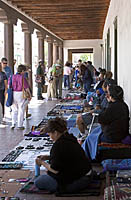 Running along the north side of the Plaza, the Palace of the Governors, built in 1610, is the oldest continually occupied public building in the United States, having served as the political seat of multiple governments for its first three centuries. In 1909 it became the initial site of the Museum of New Mexico. The Palace of the Governors currently houses the Museum’s state history collection from Spanish colonial, Mexican, American Territorial through recent New Mexican history. It is a good place to get an overview of New Mexico’s tri-cultural past.
Running along the north side of the Plaza, the Palace of the Governors, built in 1610, is the oldest continually occupied public building in the United States, having served as the political seat of multiple governments for its first three centuries. In 1909 it became the initial site of the Museum of New Mexico. The Palace of the Governors currently houses the Museum’s state history collection from Spanish colonial, Mexican, American Territorial through recent New Mexican history. It is a good place to get an overview of New Mexico’s tri-cultural past.
On permanent exhibit is Art of Ancient America, 1500 BC- AD 1500, a beautiful collection of 300 years of pre-Columbian ceramic and metal figures from tombs in Mexico, Peru and other Mesoamerican countries. The collection includes human effigies, animals, fruits and other objects. A gleeful stone figure caries a pole across his shoulders. A ceramic lobster is painted in the grey and rust shades of Mexican pottery. Hammered gold masks gleam with mysterious expressions.
The Segesser Hides, the earliest known depiction of Spanish and French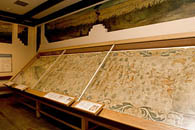 colonial occupation in the New World, are also on permanent display. The artist chronicled history on bison hides in the early 18 th century. The first panel depicts an Apache attack. Segasser II tells the story of a 1720 expedition led by the Lt. Governor of New Mexico, Don Pedro de Villasur, which was ambushed in what is now Nebraska. Named after a Swiss priest who sent the hides back to his family in Switzerland in the 1750s, they were purchased by the Museum of New Mexico and brought to the Palace of the Governors in the 1980s.
colonial occupation in the New World, are also on permanent display. The artist chronicled history on bison hides in the early 18 th century. The first panel depicts an Apache attack. Segasser II tells the story of a 1720 expedition led by the Lt. Governor of New Mexico, Don Pedro de Villasur, which was ambushed in what is now Nebraska. Named after a Swiss priest who sent the hides back to his family in Switzerland in the 1750s, they were purchased by the Museum of New Mexico and brought to the Palace of the Governors in the 1980s.
Other artifacts on permanent display include Spanish armor, a mud wagon, implements of the Anglo Frontier and the Mexican Period, and several room installations including a New Mexico Chapel based around an 1830 altar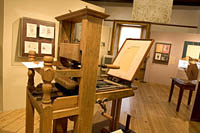 piece painted by folk artist Jose Rafael Aragon for the church of Llano Quemado in Taos County.
piece painted by folk artist Jose Rafael Aragon for the church of Llano Quemado in Taos County.
Through February 4, 2007 you can also see “Lasting Impressions,” an exhibit of New Mexico’s literary history. Original printing presses and first edition woodcut print books from illustrated Shakespeare to Native American folk tales are on display.
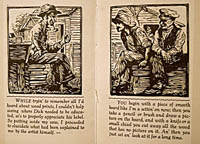 Some of the works printed by the independent presses are quite entertaining, showing biting political or social satire. The Museum continues to use historic hand-operated printing and bookbinding
Some of the works printed by the independent presses are quite entertaining, showing biting political or social satire. The Museum continues to use historic hand-operated printing and bookbinding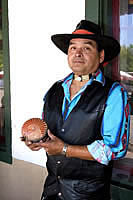 equipment to produce limited editions of works related to the Southwest through the Palace Press.
equipment to produce limited editions of works related to the Southwest through the Palace Press.
In front of the Palace of the Governors, New Mexico American Indian vendors sell handcrafted objects as part of the Museum’s Native American Artisans Program. The Museum stipulates that vendors can only sell items that are handmade by themselves or immediate family members.
The pilgrimage to the Museum of New Mexico continues: Museum of Fine Arts, The Museum of Indian Arts and Culture and the Museum of International Folk Arts.
For more information, visit www.palaceofthegovernors.org

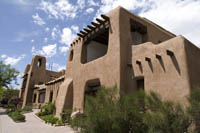 Across the street on the north-west corner of the Plaza is the Museum of Fine Arts. Built in 1917 to house the Museum of New Mexico’s art collection, the Pueblo Revival structure is a blend of Native American and Spanish colonial design. The collection focuses on painting, photography, works on paper and sculpture created in or related to New Mexico and the Southwest.
Across the street on the north-west corner of the Plaza is the Museum of Fine Arts. Built in 1917 to house the Museum of New Mexico’s art collection, the Pueblo Revival structure is a blend of Native American and Spanish colonial design. The collection focuses on painting, photography, works on paper and sculpture created in or related to New Mexico and the Southwest.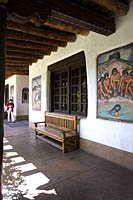 The museum’s heavily beamed auditorium features murals depicting the life of the city’s patron, St. Francis of Assisi, designed by Donald Beauregard. The murals were finished by Carlos Vierra and Kenneth M. Chapman after Beauregard’s death. Murals around the courtyard depict Native American culture in the New Mexico landscape.
The museum’s heavily beamed auditorium features murals depicting the life of the city’s patron, St. Francis of Assisi, designed by Donald Beauregard. The murals were finished by Carlos Vierra and Kenneth M. Chapman after Beauregard’s death. Murals around the courtyard depict Native American culture in the New Mexico landscape.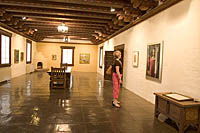 complex relationships among of the New Mexico arts, social, philanthropic and political communities. It brings into focus the small-town environment of the Santa Fe and Taos arts communities , where anyone of note is likely to know everyone else. New Mexico Connections runs through January 9, 2006. A related exhibit, Self Portraits from the Permanent Collection, shows self portraits of some of the artists in the other exhibits, including Donald Beauregard who painted the murals in the auditorium. It runs through June 12, 2005.
complex relationships among of the New Mexico arts, social, philanthropic and political communities. It brings into focus the small-town environment of the Santa Fe and Taos arts communities , where anyone of note is likely to know everyone else. New Mexico Connections runs through January 9, 2006. A related exhibit, Self Portraits from the Permanent Collection, shows self portraits of some of the artists in the other exhibits, including Donald Beauregard who painted the murals in the auditorium. It runs through June 12, 2005.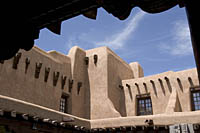 June 10 through October 10, 2005 the Museum will open a new exhibit featuring the bronze horses, dancers and women of French artist Edgar Degas along side new bronze works from New Mexico’s artists and foundries inExplorations in Bronze: Degas and New Mexico Sculptors.
June 10 through October 10, 2005 the Museum will open a new exhibit featuring the bronze horses, dancers and women of French artist Edgar Degas along side new bronze works from New Mexico’s artists and foundries inExplorations in Bronze: Degas and New Mexico Sculptors.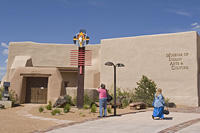 The M bus runs from the Plaza to Museum Hill, where four outstanding museums provide incentive to venture outside the city center. Two of these are part of the Museum of New Mexico.
The M bus runs from the Plaza to Museum Hill, where four outstanding museums provide incentive to venture outside the city center. Two of these are part of the Museum of New Mexico.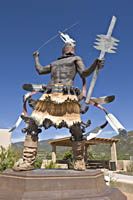 I didn’t have nearly enough time to spend at the Museum of Indian Arts and Culture (MIAC) and Laboratory of Anthropology. Between them, they contain the most comprehensive collection of Southwestern anthropological artifacts in existence including over 10 million artifacts from over 12,000 archeological sites across New Mexico as well as Native American artifacts from across North America. Of course, only a fraction of these are displayed in the permanent and temporary museum exhibits. The MIAC also has touring exhibits and online exhibits that can be accessed from their web site.
I didn’t have nearly enough time to spend at the Museum of Indian Arts and Culture (MIAC) and Laboratory of Anthropology. Between them, they contain the most comprehensive collection of Southwestern anthropological artifacts in existence including over 10 million artifacts from over 12,000 archeological sites across New Mexico as well as Native American artifacts from across North America. Of course, only a fraction of these are displayed in the permanent and temporary museum exhibits. The MIAC also has touring exhibits and online exhibits that can be accessed from their web site.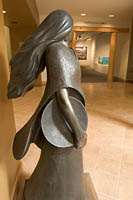 The experiential exhibit, Here, Now and Always, uses the voices of fifty Native Americans to guide visitors through their diverse communities and histories. Narrative, poems and songs give life to the 1300 artifacts of daily life displayed in environmental context.
The experiential exhibit, Here, Now and Always, uses the voices of fifty Native Americans to guide visitors through their diverse communities and histories. Narrative, poems and songs give life to the 1300 artifacts of daily life displayed in environmental context.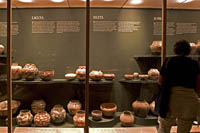 In the Buchsbaum Gallery of Southwestern Pottery nearly 300 pieces of Pueblo pottery are on display. Some of the earliest known pieces are on display, as well as the work of living Pueblo potters continuing the coiled pottery tradition.
In the Buchsbaum Gallery of Southwestern Pottery nearly 300 pieces of Pueblo pottery are on display. Some of the earliest known pieces are on display, as well as the work of living Pueblo potters continuing the coiled pottery tradition.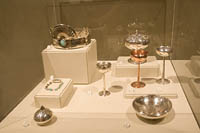 The work of 20 th century Cochiti silversmith Joe H. Quintana from the collection of Irma Bailey is on display through September 1, 2005. Items include intricate silver and turquoise jewelry, goblets, boxes and even a silver and turquoise dog collar that Quintana made for Bailey’s dog.
The work of 20 th century Cochiti silversmith Joe H. Quintana from the collection of Irma Bailey is on display through September 1, 2005. Items include intricate silver and turquoise jewelry, goblets, boxes and even a silver and turquoise dog collar that Quintana made for Bailey’s dog.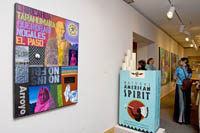 Through January 16, 2006, Iconoclashshows the work of David Bradley (Minnesota Chippewa) and Marcus Amerman (Choctaw). Both artists use painting and sculpture to satirize the way that mainstream American culture trivializes Native American people and culture by creating one-dimensional icons and labels.
Through January 16, 2006, Iconoclashshows the work of David Bradley (Minnesota Chippewa) and Marcus Amerman (Choctaw). Both artists use painting and sculpture to satirize the way that mainstream American culture trivializes Native American people and culture by creating one-dimensional icons and labels.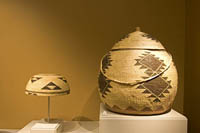 In the new Masterpieces Gallery, Beauty Within shows the artistry of 100 practical Native American objects including a Chilkat blanket from the Northwest coast, painted pre-Columbian pots, intricate basketry, embroidered and beaded clothing, clay figurines and two exquisite black on black pots by famed San Ildefonso potter Maria Martinez. Beauty within closes October 23, 2005.
In the new Masterpieces Gallery, Beauty Within shows the artistry of 100 practical Native American objects including a Chilkat blanket from the Northwest coast, painted pre-Columbian pots, intricate basketry, embroidered and beaded clothing, clay figurines and two exquisite black on black pots by famed San Ildefonso potter Maria Martinez. Beauty within closes October 23, 2005.